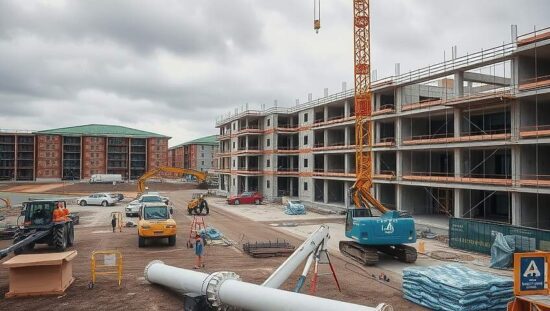Construction Sector Shows Mixed Signals Amidst Policy Scrutiny
Germany’s construction industry delivered a complex picture in August 2025, revealing a sector grappling with fluctuating demand and potentially facing headwinds from evolving government infrastructure priorities. While real (inflation-adjusted) incoming orders in the main construction crafts rose by 2.4% compared to July 2025, a closer examination highlights a crucial divergence within the industry.
The surge in orders was disproportionately driven by a substantial 11.5% increase in high-rise building projects, a trend analysts attribute to ongoing private investment and a potential race against tightening building regulations anticipated in late 2025. Conversely, civil engineering projects experienced a notable 5.0% decline, a worrying sign suggesting a cooling of demand for public infrastructure work.
Looking at a three-month average (June-August 2025), incoming orders were 3.2% lower than the period spanning May to July 2025. The persistent underperformance of the civil engineering sector, with a -7.6% drop over this period, stands in stark contrast to the slight uptick in high-rise building, raising questions regarding the long-term sustainability of the current trajectory. This discrepancy coincides with ongoing political debates surrounding the government’s investment plans for transport infrastructure and renewable energy projects, with some critics alleging overly bureaucratic processes and shifting funding priorities are hindering progress.
Compared to August 2024, real incoming orders registered an increase of only 0.1%, underlining the sector’s struggle to maintain prior growth rates. The 9.2% rise in high-rise building orders was offset by a 7.6% decrease in civil engineering, further demonstrating the uneven nature of the current rebound. Nominal incoming orders edged up slightly, indicating a minimal overall gain despite substantial variations across disciplines.
The real turnover in the main construction crafts was 5.0% lower than in August 2024, while nominal turnover dropped by 2.7% to €9.9 billion. Although cumulative real turnover for the first eight months of 2025 increased by 1.0% and nominal turnover by 3.5%, these figures are viewed with caution, particularly given the ongoing concerns about project delays and rising materials costs.
Simultaneously, the number of individuals employed in the main construction crafts increased by 1.4% compared to August 2024. This rise in personnel, while seemingly positive, may indicate pressure to meet existing project demands, potentially exacerbating existing labor shortages and contributing to cost escalation.
The data paints a complicated narrative: a construction sector appearing to benefit from private investment in high-rise projects whilst navigating potential hurdles stemming from government policy and a weakening demand for essential public infrastructure work. The coming months will be crucial in determining whether the current imbalance proves to be a temporary correction or an indication of fundamental shifts within Germany’s construction landscape.





